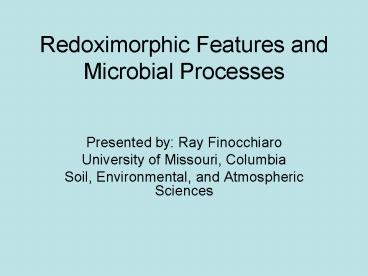Redoximorphic Features and Microbial Processes - PowerPoint PPT Presentation
1 / 32
Title:
Redoximorphic Features and Microbial Processes
Description:
Various Colors of Gray, Red, Yellow, Brown, and Blacks. ... Fe2 (ferrous) highly leachable, when reduced or removed allows gray soil colors ... – PowerPoint PPT presentation
Number of Views:33
Avg rating:3.0/5.0
Title: Redoximorphic Features and Microbial Processes
1
Redoximorphic Features and Microbial Processes
- Presented by Ray Finocchiaro
- University of Missouri, Columbia
- Soil, Environmental, and Atmospheric Sciences
2
(No Transcript)
3
4
(No Transcript)
5
- What are redoximorphic features, why are they
used, - and where are they found.
- Microbial Processes Involved with these
Features. - Specific examples of redoximorphic features and
how - they are formed.
6
Redoximorphic Features
- Formed by the reduction, movement, and oxidation
of Fe and Mn compounds. - Various Colors of Gray, Red, Yellow, Brown, and
Blacks. - Associated with seasonally saturated and reduced
soil. - Most widespread morphological feature formed by
redox reactions.
7
Importance Of Redox Features
- Easy to identify in the field.
- Reliable and long lasting.
- Indicators of Soil Drainage Characteristics.
- Delineate wetlands (U.S. policy)
- 1849 Swamp Act swamp clearing
- 1929 Migratory Bird Conservation Act
- 1972 Clean Water Act (404)
- 1977 Executive Order 11990
- 1985 FSA (Farm Bill / Swampbuster)
- 1988 1993 The National Wetlands Policy Forum
8
Where are these features found
- Hydric Soil are wet long enough to periodically
produce anaerobic conditions, thereby influencing
the growth of plants. - Form under a variety of hydrological regimes
(i.e., permanent seasonal)
9
Redox Chemistry and Hydric Soil
- Soil Must be saturated and reduced
- Induces biological chemical processes that
change the soil from an aerobic and oxidized
state to anaerobic and reduced state. - Allows chemical reactions to occur that develop
the common characteristics found in hydric soils
(OM, gray colors, H2S, CH4)
10
Microbial Processes Redox
- (BIG) (SMALL)
- OM soil fauna OM soil flora
- Sugars AA soil flora e- H
(oxidation) - reduced substance H20
- (reduction)
11
Reduction and Respiration
- Aerobic (air-rich conditions)
- Oxygen is the main TEA
- Anaerobic
- The major TEA compounds NO3-, MnO2, Fe(OH)3,
SO42-, and CO2 (theoretically) - Not all bacteria use the same TEAs but most soils
contain all microbial species necessary to reduce
these compounds.
12
Factors Leading to Reduction in Soils
- Saturated to exclude oxygen from the soil
- Contain OM that can be oxidized / decomposed
- Microorganisms must be respiring and oxidizing OM
- Stagnant or slow moving water
13
Principal Reduction Reactions in Hydric Soils
- Denitrification (NO3- NO2-)
- Fe and Mn reduction (production of mottles)
- SO42- reduction (H2S production)
- CO2, CO32- reduction (CH4)
14
Fe and Mn Reduction
- Rates and extent of reduction dependent on forms
of oxides - Fe2 (ferrous) highly leachable, when reduced or
removed allows gray soil colors - NO3- inhibits reduction of Fe oxides
- Mn reduction can occur with NO3-
15
Types of Redoximorphic Features
- Redox Concentrations
- Redox Depletions
- Reduced Matrix
16
Redox Concentrations
- Bodies of apparent accumulation of Fe and Mn
oxides.
17
(No Transcript)
18
Nodules and Concretions
- Firm to extremely firm irregularly shaped bodies
with diffused boundaries.
19
(No Transcript)
20
Masses
- Soft bodies, frequently within the matrix, whose
shape is variable.
21
(No Transcript)
22
(No Transcript)
23
Pore Linings
- Zones of accumulation that may be either coatings
on a pore surface or impregnations of the matrix
adjacent to the pore.
24
(No Transcript)
25
Redox Depletions
- Bodies of low chroma ( 2) having values of four
or more where Fe-Mn oxides alone have been
stripped out or where both Fe-Mn oxides and clay
have been stripped out.
26
(No Transcript)
27
Fe depletions are low chroma bodies with clay
contents similar to that of the adjacent matrix.
Fe depletions can occur along pores and in the
matrix.
28
(No Transcript)
29
Formation of Redoximorphic Features
30
(No Transcript)
31
(No Transcript)
32
Summary
- Red, yellow, browns and black colors are produced
by the Fe and Mn oxides. - In anaerobic conditions these oxides can be
reduced by microbial respiration. - Once reduced the soil develops the characteristic
grays (gley) coloring.































